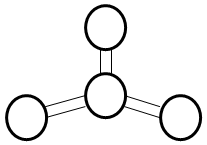This set of Class 11 Chemistry Chapter 4 Multiple Choice Questions & Answers (MCQs) focuses on “Valence Shell Electron Pair Repulsion (VSEPR) Theory”.
1. Which of the following is correct regarding repulsive interaction?
a) Lone pair-Lone pair is greater than Lone pair-Bond pair is greater than Bond pair-Bond pair
b) Lone pair-Lone pair is less than Lone pair-Bond pair is less than Bond pair-Bond pair
c) Lone pair-Bond pair is greater than Lone pair-Lone pair is greater than Bond pair-Bond pair
d) Lone pair-Lone pair is greater than Lone pair-Bond pair is less than Bond pair-Bond pair
View Answer
Explanation: The repulsive interactions follow the above order. The lone pairs are localized on the central atom, each bonded pair is shared between two atoms. So, the lone pair electrons in a molecule occupy more space as compared to the bonding pairs of electrons.
2. The shape of the molecule depends on the _______
a) adjacent atom
b) valence electrons
c) surroundings
d) atmosphere
View Answer
Explanation: As the postulate of Valence Shell Electron Pair Repulsion Theory (VSEPR), the shape of the molecule depends on the number of valence shell electron pairs around the atom (both bonded and non-bonded).
3. The shape a molecule occupies allows to minimize repulsions among them and maximize the space between them.
a) True
b) False
View Answer
Explanation: As the postulate of Valence Shell Electron Pair Repulsion Theory (VSEPR), a molecule tends to form a shape or orientation that has little repulsion comparatively and the higher distance between the electron pairs comparatively.
4. What is the shape of the molecule NH3?
a) Square pyramidal
b) V-shape
c) Triagonal pyramidal
d) Tetrahedral
View Answer
Explanation: The molecule NH3 has a lone pair and 3 bond pairs. As we know that the repulsion order is as follows: Lone pair-Lone pair is greater than Lone pair-Bond pair is greater than Bond pair-Bond pair. So the shape of molecule NH3 is trigonal pyramidal, where the lone pair is away from the 3 bond pairs.
5. How many orbitals are included in sp3d hybridization?
a) 5
b) 4
c) 3
d) 6
View Answer
Explanation: The concept of mixing of atomic orbitals and formation of new hybridized atomic orbitals for the pairing of electrons through chemical bonds. Therefore sp3d hybridization included 5 orbitals namely 1 s-orbital, 3 p-orbitals, and 1 d-orbital.
6. A double bond is made up of __________
a) Two sigma bonds
b) Two pi bonds
c) One sigma and one pi bond
d) Two sigmas and one pi bond
View Answer
Explanation: A double bond is formed chemically between two atoms that involve the bonding of four electrons. A double bond is formed with one sigma and one pi bond. The formation of molecules like ethane, oxygen involve double bonds.
7. Which of the following molecules geometry is true?
a) BrF5 – Triagonal pyramidal
b) ClF3 – T-shape
c) PCl5 – See-saw
d) SF4 – Triagonal bipyramidal
View Answer
Explanation: The molecule ClF5 has T-shape as it 3 bonding pairs and 2 lone pairs, so it’s true. The molecules BrF5, PCl5, and SF4 have the shapes square pyramidal, trigonal bipyramidal and see-saw respectively.
8. What is the shape of water?
a) Triagonal
b) Triagonal bipyramidal
c) Bent
d) Square planar
View Answer
Explanation: The water molecule H-O-H has an arrangement of electrons in a tetrahedral. As it contains two bond pairs and lone pairs in the form of the molecule of type AB3E2, it’s shape is bent i.e. neglecting the lone pairs.
9. What is the name of the below-given shape?

a) Triagonal planar
b) Tetrahedral
c) Square planar
d) Octahedral
View Answer
Explanation: In the above shape, each bond from the center is separated by 120°. So the above shape is trigonal planar. Few examples of the trigonal planar are boron trifluoride, sulfur trioxide, and borane with sp2 hybridization.
10. The angle between two bonds in a linear molecule is _______
a) 108°
b) 180°
c) 74.5°
d) 90°
View Answer
Explanation: A linear molecule has a hybridization sp, in which the bonds between the central atom and other atoms are separated by 180°. For example, let’s take carbon dioxide, it’s shape is given by O=C=O.
Sanfoundry Global Education & Learning Series – Chemistry – Class 11.
To practice all chapters and topics of class 11 Chemistry, here is complete set of 1000+ Multiple Choice Questions and Answers.
If you find a mistake in question / option / answer, kindly take a screenshot and email to [email protected]
- Practice Class 11 - Physics MCQs
- Practice Class 11 - Mathematics MCQs
- Practice Class 11 - Biology MCQs
- Practice Class 12 - Chemistry MCQs
- Check Class 11 - Chemistry Books
